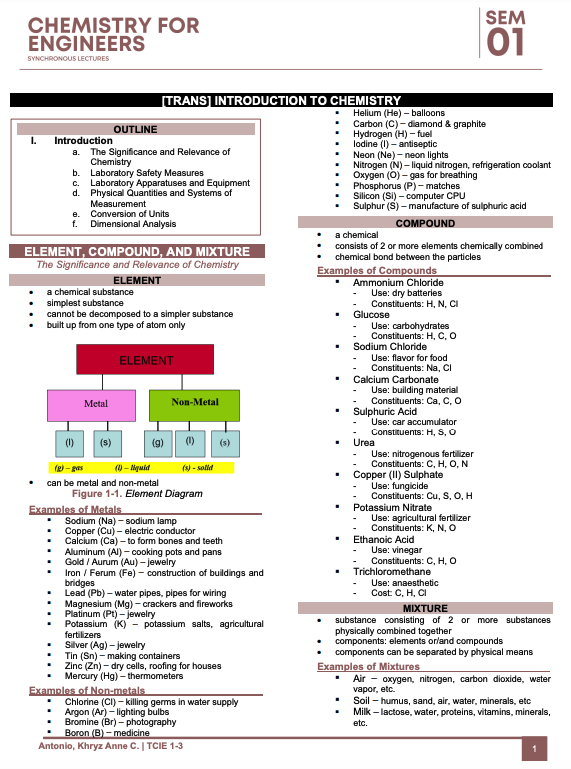Chemistry for Engineers – Prelim Course Summary
Summary:
This introduction to chemistry covers the basic definitions and examples of elements, compounds, and mixtures. Elements, defined as the simplest substances made up of one type of atom, can be either metals or non-metals, with examples such as Sodium (Na) for metals, and Chlorine (Cl) for non-metals, among others. Compounds consist of two or more elements chemically combined, with examples including Ammonium Chloride and Glucose. Mixtures consist of two or more substances physically combined, for example, air and soil. It also delves into laboratory safety measures, apparatuses, equipment used in chemistry, and their functions. For instance, a Bunsen burner is used for heating, a beaker for holding water, a volumetric flask for precise dilutions, etc. This introduction also includes instructions on laboratory techniques such as transferring solid and liquid chemicals, measuring solid and liquid substances using electronic balance and graduated cylinders, respectively, and heating liquids and solids. Finally, it ends with review questions to assess the learner’s understanding of the material.
Excerpt:
Chemistry for Engineers
LABORATORY SKILLS AND TECHNIQUES
Laboratory Procedure / Safety Measures
TRANSFERRING SOLID CHEMICALS
• solid substances are kept in reagent bottles
• the use of dark-coloured bottles is used to protect the chemicals from light
• reagent bottles can have a flat top or winged top for their stopper
• solid chemicals are spooned out from the reagent bottle using a spatula
• when transferring chemicals to a small-mouthed container, a piece of paper is used
Procedure
1. Get a piece of clean paper. Fold it lengthwise.
2. Transfer the solid reagents to the edge of the paper.
3. Hold the test tube horizontally, and slide the paper until it touches the bottom part of the container.
4. Incline the apparatus and tap the paper gently. This ensures that the solid substance is deposited at the bottom of the test tube and not on the sides.
MEASURING SOLID SUBSTANCES USING AN ELECTRONIC BALANCE
• electronic balances allow the user to quickly and accurately measure the mass of a substance to a level of accuracy (impossible for traditional balances to achieve) that is especially important in experiments that require precise amounts of each substance to achieve the desired results


Reviews